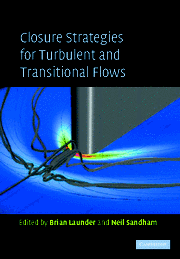3 - Closure Modelling Near the Two-Component Limit
Published online by Cambridge University Press: 06 July 2010
Summary
Introduction
Most widely-used turbulence models have been developed and tested with reference to flows near local equilibrium, where there are only moderate levels of Reynolds stress anisotropy. The present contribution considers the development of models which are designed to give the correct behaviour in much more extreme situations, where the turbulence approaches a 2-component state.
To illustrate the type of flow situation to be considered, Figure 1 illustrates the flow in the vicinity of a wall. While all turbulent velocity components must vanish at the wall, the normal fluctuations, v, must vanish more rapidly since by continuity ∂v/∂y must always be zero there (as ∂u/∂x and ∂w/∂z both vanish), Figure 2. A similar two-component structure arises close to the free surface of a liquid flow where again fluctuating velocities normal to the free surface become negligible compared with fluctuations lying in the plane of the free surface. Clearly, the turbulence structure in such a flow will be very different from that found in free flows, where the stress anisotropy is much smaller. Consequently, it might be expected that simple models developed and tuned for the latter flows are unlikely to give good predictions in near-wall or free-surface regions, or other flows which are close to the 2-component limit.
The importance of explicitly respecting this two-component limit in turbulence modelling originated from two papers from the 1970s. First, a short note by Schumann (1977) advocated that modelling proposals should make it impossible for unrealizable values of the turbulence variables to be generated (such as negative values for the mean square velocity fluctuations in any direction). Shortly thereafter, Lumley (1978) remarked that if such realizability was to be ensured one needed to focus on the behaviour of the model at the moment when one of the velocity components had just fallen to zero. When this two-component state has been reached one must ensure that, for the normal stress that has fallen to zero, its rate of change also vanishes. That is essential to prevent the stress field achieving unrealizable values at the next instant of time.
Shih and Lumley (1985) were the first to apply realizability constraints to the modelling of the pressure correlation terms in both the Reynolds stress and scalar flux transport equations.
- Type
- Chapter
- Information
- Closure Strategies for Turbulent and Transitional Flows , pp. 102 - 126Publisher: Cambridge University PressPrint publication year: 2002
- 3
- Cited by



